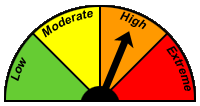Important!
Homes that have been framed from wood are generally quite resistant to storm damage. Watching tall trees in a strong wind demonstrates this resistance. It is unlikely that conventionally-framed houses with wooden skeletons will collapse. This is the case, however, only if the home remains on its foundation and the roof, ceiling and walls remain connected.
Foundation
- Check your house and garage for foundation bolts. It is strongly recommended that you have your home
inspected to ensure anchor bolts have been properly installed. Newer homes built to Code will have them. These bolts secure the wood structure to the concrete foundation. They are placed approximately 2 metres
(~6 feet) apart along the sill plate. They may also have been screwed into the concrete. - Using a hammer drill and carbide bit, drill a hole through the sill plate into the foundation. Place these
holes every 2 metres (~6 feet). - Drop a ½” x 8” expansion bolt into the hole and finish by tightening the nut and washer. Tapcon-type screws are also acceptable.
Mobile Home Foundations
It is relatively easy for a mobile home to be thrown off its supports during a storm event.
- Leave the wheels on the coach to limit its fall if the jacks or pier supports fail.
- Check the undercarriage to make sure that it has been securely tied to the foundation.
- Tie double wide mobiles together. The two halves generally are of different weights. Because of this, they
move differently in a wind storm and can easily pull apart.
Strengthening the frame
For a building to stay together in a wind storm, all its parts must be fastened together. Metal connectors
(brackets) are used to strengthen places where the posts and beams of the walls, and the floor and ceiling
join.
- Strengthen the connection between ceilings, walls and floors using the appropriate metal hardware.
- Inspect all exposed framing in garages, basements, porches and patio covers. Strengthen this where
necessary.
Brick and masonry
- Brick, masonry and stone facades are very susceptible to tornado or wind damage. Family members need to keep away from such facades. If you have a large amount of brick or stone in your home you may want to consult a structural engineer for advice on how to better secure it.
Chimney
One of the most common types of damage suffered is a toppled chimney. This becomes extremely dangerous if falling bricks penetrate the roof and fall into the rooms below.
- Check the chimney for loose tiles and bricks.
- If you can get to it from the attic, it’s a good idea to reinforce the ceiling surrounding the chimney with ¾” plywood nailed to the beams. This will provide protection from falling bricks that might break through the roof.
Windows
Windows are a major hazard in a tornado. As the building moves, pressure builds up on the windows which may result in them shattering. Be sure to stay clear of windows during tornado or heavy wind warnings.
- Consider adding a safety film to the inside of all windows greater than 60 square centimetres (2 square feet) in size. This does not prevent the window from cracking, but it does keep the glass from falling and injuring loved ones.
- Can be used on mirrors as well to keep them from shattering during a tornado.






